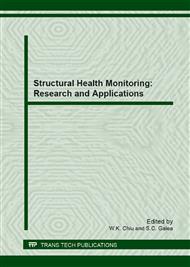[1]
Younho, C. (2000). Estimation of ultrasonic guided wave mode conversion in a plate with thickness variation. Ultrasonics, Ferroelectrics and Frequency Control, IEEE Transactions on, 47(3): 591-603.
DOI: 10.1109/58.842046
Google Scholar
[2]
Dalton, R. P., Cawley, P., and Lowe, M. J. S. (2001). The potential of guided waves for monitoring large areas of metallic aircraft fuselage structure. Journal of Nondestructive Evaluation, 20(1): 29-46.
Google Scholar
[3]
Park, H. W., Kang, J. S., Hong, J.-W., and Sohn, H. (2008). Understanding The Effects Of Complex Structural Features On Guided Wave Propagation In the Proceedings of the 15th nternational Congress on Sound and Vibration, Daejeon, Korea.
Google Scholar
[4]
Lin, X., and Yuan, F. G. (2001). Detection of Multiple Damages by Prestack Reverse-Time Migration. AIAA J., 39(11): 2206-2215.
DOI: 10.2514/2.1220
Google Scholar
[5]
Larmat, C. S., Guyer, R. A., and Johnson, P. A. (August 2010). Time-reversal methods in geophysics Physics Today: 31-35
DOI: 10.1063/1.3480073
Google Scholar
[6]
Ing, R. K., and Fink, M. (1998). Time-reversed Lamb waves. IEEE Transactions on Ultrasonics, Ferroelectrics, and Frequency Control, 45(Compendex): 1032-1043.
DOI: 10.1109/58.710586
Google Scholar
[7]
Xu, B., and Giurgiutiu, V. (2007). Single mode tuning effects on lamb wave time reversal with piezoelectric wafer active sensors for structural health monitoring. Journal of Nondestructive Evaluation, 26(Compendex): 123-134.
DOI: 10.1007/s10921-007-0027-8
Google Scholar
[8]
Sohn, H., Park, H. W., Law, K. H., and Farrar, C. R. (2007). Combination of a Time Reversal Process and a Consecutiv Outlier Analysis for Baseline-free Damage Diagnosis. Journal of Intelligent Material Systems and Structures, 18(4): 335-346.
DOI: 10.1177/1045389x0606629
Google Scholar
[9]
Kim, S. B., and Sohn, H. (2006). Application of time-reversal guided waves to field bridge testing for baseline-free damage diagnosis. Health Monitoring and Smart Nondestructive Evaluation of Structural and Biological Systems V San Diego, CA, USA Proc. SPIE. Vol. 6177: p.617706.1-617706.10
DOI: 10.1117/12.659728
Google Scholar
[10]
Gangadharan, R., Murthy, C. R. L., Gopalakrishnan, S., and Bhat, M. R. (2009). Time reversal technique for health monitoring of metallic structure using Lamb waves. Ultrasonics, 49(8): 696-705.
DOI: 10.1016/j.ultras.2009.05.002
Google Scholar
[11]
Woo, P. H., Bum, K. S., and Sohn, H. (2009). Understanding a time reversal process in Lamb wave propagation. Wave Motion, 46(7): 451-467.
DOI: 10.1016/j.wavemoti.2009.04.004
Google Scholar
[12]
Wang, D., Ye, L., Su, Z., Lu, Y., Li, F., and Meng, G. (2010). Probabilistic Damage Identification Based on Correlation Analysis Using Guided Wave Signals in Aluminum Plates. Structural Health Monitoring, 9(2): 133-144.
DOI: 10.1177/1475921709352145
Google Scholar
[13]
Mustapha, S., Ye, L., Wang, D., and Lu, Y. (2012). Debonding Detection in Composite Sandwich Structures Based on Guided Waves. AIAA 50(8): 1697-1706.
DOI: 10.2514/1.j051274
Google Scholar
[14]
Dulieu-Barton, J. M., Boyenval Langlois, C., Thomsen, O. T., Zhang, S., and Fruehmann, R. K. (2010). Derivation of temperature dependent mechanical properties of polymer foam core materials using optical extensometry. EPJ Web of Conferences, 6: 38004.
DOI: 10.1051/epjconf/20100638004
Google Scholar
[15]
Mustapha, S., Ye, L., Wang, D., and Lu, Y. (2011). Assessment of debonding in sandwich CF/EP composite beams using A0 Lamb wave at low frequency. Composite Structures, 93(2): 483-491.
DOI: 10.1016/j.compstruct.2010.08.032
Google Scholar


